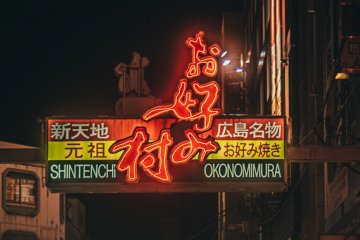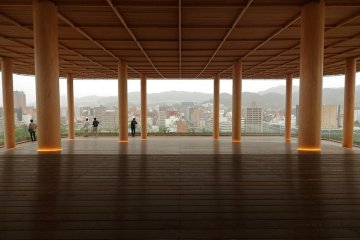
L'Auberge J-Hoppers à Hiroshima
Geraldine BartoliJ-Hoppers, l’une des auberges de jeunesse les moins chères et les plus agréables que vous puissiez trouver à Hiroshima !

Hondori (本通) is one of the main shopping districts in Hiroshima's bustling downtown area. This pedestrian arcade street (shotengai) is a shopper's paradise, lined with everything from clothing stores, trendy boutiques, cafes and restaurants, through to karaoke bars, gaming arcades, purikura parlours and anime shops. When it comes to shopping in Hiroshima, Hondori is a popular choice. As a covered walkway, shoppers can also feel protected from the elements allowing plenty of time to find the perfect souvenir come rain or shine.
Hondori is perfectly placed in the heart of Hiroshima's downtown and an easy, worthwhile stop on any Hiroshima itinerary. The street stretches for over half a kilometer from Peace Park in the west (near Sunmall), to the PARCO department store to the east (in the direction of Nagarekawa). It's easy to explore Hondori in combination with other sightseeing spots.
For food, try local brands like Andersen's Bakery, the famous Okonomimura just off the eastern side, the well-known The Shack Bar and Grill, (moved from its original Chuodori location) or just keep things simple at the Starbucks on the eastern side — a popular meeting spot for locals, alongside the nearby Alice Garden.
When shopping in Hiroshima, you can come across some interesting local chains, like Fresta, Wants and Edion (formerly DeoDeo)—not to mention some interesting heritage. Hiroshima is not just the home for Mazda, but also where it began for another global brand: Uniqlo. Just a few blocks away from Hondori towards Fukuromachi you can stumble across the building where the original branch for 'Unique Clothing Warehouse' (as it was originally known) started back in 1984. It's now occupied by a different business (Chacott), but easy to find being right next door to Hiroshima's branch of Paul Smith.
Hondori is reliably busy at all times of the day, with many shops and cafes open until late. For a rainy day excursion, you can continue your shopping journey underground too — the entrance to the Kamiyacho Shareo underground mall can be located at the Hondori Streetcar stop.
Hiroden Streetcar: Hondori can be accessed via the Hiroden tram network via its own streetcar stop. Routes 1, 3 and 7 all pass through Hondori station, though a number of other stops all provide good access to Hondori too: Kamiyacho-nishi, Kamiyacho-higashi, Tatemachi and Hatchobori.
Astram Line: Hondori Station is the terminus for the Astram Line rapid transit system, which connects the city centre to the north-west suburbs. The line reaches all the way to Asaminami ward — a full journey takes about 40 minutes and the last stop, Kōiki-kōen-mae, is home to Sanfrecce Hiroshima, at their Big Arch / Edion Stadium.
City Buses: It's about a 10 min bus ride via Hiroshima Station — alight anywhere along Aioi-dori Avenue that runs parallel to Hondori which is just a few minutes walk away.
Limousine bus: it's about a 5 minute walk from Hiroshima Bus Centre, up on the third floor of Sogo department store, which connects to Hiroshima Airport.
By foot: A few minutes east from Peace Park.

J-Hoppers, l’une des auberges de jeunesse les moins chères et les plus agréables que vous puissiez trouver à Hiroshima !

Okonomimura est un parc à thème gastronomique dédié aux okonomiyaki d'Hiroshima, plat très répandu au Japon et situé près de l'extrémité est de la rue commerçante Hondōri à Hiroshima. On y trouve 24 restaurants d'okonomiyaki, chacun avec un style et une sélection d'ingrédients légèrement différents L'okonomiyaki est proche du "Issen Yoshoku" ("repas occidental à un centime"), un plat populaire auprès des gens ordinaires pendant l'ère d'avant-guerre. Il se composait d'une pâte de farine cuite avec des oignons, des crevettes séchées et des épices. Après la guerre, d'autres ingrédients tels que le chou, les œufs, les fruits de mer, le sarrasin et les nouilles de blé ont été utilisés pour améliorer l'alimentation en ces temps difficiles. C'est ainsi qu'est né l'okonomiyaki dans la ville d’Hiroshima. [Photo: Victor Lee / CC BY-NC-ND 2.0]

"Carried to Hiroshima from Tinian Island by the Enola Gay, a U.S. Army B-29 bomber, the first atomic bomb used in the history of humankind, exploded approximately 580 meters above this spot. The city below was hit by heat rays of approximately 3,000 to 4,000°C, along with a blast wind and radiation. Most people in the area lost their lives instantly. The time was 8:15 a.m., August 6, 1945." This plaque on a downtown Hiroshima sidestreet marks the hypocenter of the Hiroshima atomic bombing, with the detonation of 'Little Boy' taking place 600 ft above this spot. Expect to see flowers or paper cranes left in memory at various times of the year.

With its beautiful skylines and active waterways, Oizuru Tower offers its visitors a way to see all of that activity—day or night—unobstructed by glass or rails. The wooden floors and ceilings give off a gentle warmth and the pillars that support the ceilings also provide beams of light. Instead of glass or railings, guests can feel the Hiroshima air wash over them thanks to the stainless-steel net fence. With unobstructed views of Hiroshima, including the Peace Memorial Park and the Atomic Bomb Dome (and even Mount Misen of Miyajima on clear days), the tower offers viewers a way to feel at one with the city. Hiroshima Oizuru Tower is also home to an assortment of shops and cafés. Visit the first floor to find that special souvenir of one of Hiroshima’s local products at Hito to Ki. You’ll also find Hiroshima-style okonomiyaki in Akushu Café—including unique wrap-style okonomiyaki. On the 12th floor, you can also fold your own origami crane and leave it on the Oizuru Wall with your well wishes for the future. From the 12th floor to the 1st floor, there is a slide “cool-cool-cool” that runs alongside the spiral staircase. Why not try sliding your way down twelve floors—or just a couple, as you can exit in between floors. While you take a walk inside, browse the original comic created by Shuho Sato—manga artist of “Umizaru” and “Say Hello to Black Jack”—the works inside Oizuru Tower reflect on the theme of peace. No matter what you decide to do, you’ll be delighted by the spaces and experiences that you can create. Discover the past, present, and future of Hiroshima while you gaze out at this bustling city.

The Atomic Bomb Dome, or Gembaku Dome, was once the Hiroshima Prefectural Industrial Promotion Hall. On August 6th, 1945, the world’s first atomic bomb exploded in the air directly over the building. The Hiroshima Prefectural Industrial Promotional Hall was initially built in 1915. Designed by Czech architect Jan Letzel, the building featured European construction styles and was considered both a picturesque and important site in Hiroshima city. When the atomic bomb exploded directly overhead at 8:15am on August 6th, the resulting nuclear blast killed everyone within the building itself and in the immediate vicinity. The roof was set ablaze and the walls were destroyed but the metal frame of the building was mostly left intact. In the post-war years, the hall became known colloquially as the Atomic Dome. Several renovations have been carried out on the remains over the decades, mostly to counteract severe weathering. In 1996, the dome was registered as a UNESCO World Heritage Site. Today, the A-Bomb Dome sits at the northern end of the Hiroshima Peace Memorial Park, a short walk from the Gembaku Dome tram stop (Gembaku-mae) and the city’s central shopping arcades. In the evening, muted lighting illuminates the dome. It presents a striking scene of sadness and loss but also perseverance and hope.